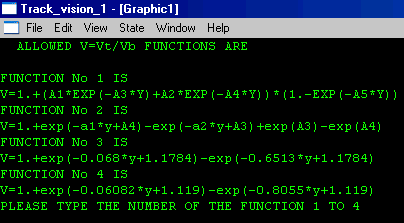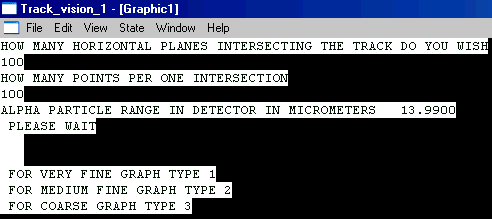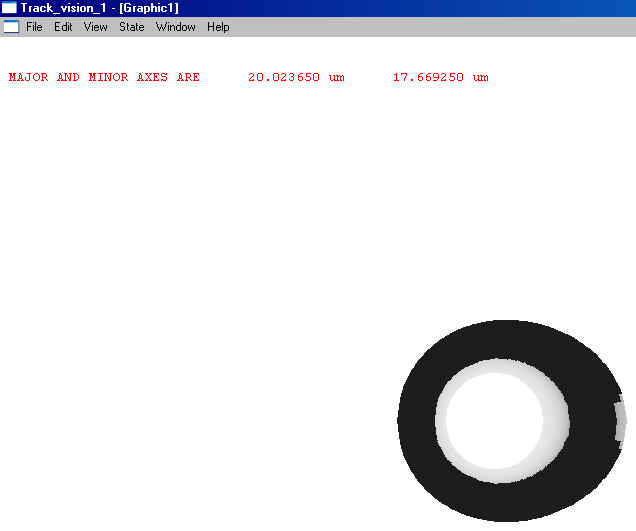|
|
|||
|
Program TRACK_VISION 2.1 |
|
|
This newest version was uploaded on 11 Mar 2021. It replaced the previous versions "TRACK_VISION 2.0" (uploaded on 13 Feb 2021) as well as "TRACK_VISION 1.0" (uploaded on on 8 Aug 2007). (Please help report any bugs to us by describing the problem and attaching your input.dat file: D. Nikezic (nikezic@knez.uis.kg.ac.yu) or K.N. Yu (peter.yu@cityu.edu.hk)).
This is a program to simulate the optical appearance of etched tracks in CR-39 and Makrofol nuclear track detectors. The program is based on our track development model:
![]() Nikezic, D., Yu, K.N.,
2003. Three-dimensional analytical determination of the track parameters. Over-etched tracks. Radiation Measurements, 37, 39-45.
Nikezic, D., Yu, K.N.,
2003. Three-dimensional analytical determination of the track parameters. Over-etched tracks. Radiation Measurements, 37, 39-45.
and another software TRACK_TEST developed by us:
![]() Nikezic, D., Yu, K.N.,
2006.
Computer
program TRACK_TEST for calculating parameters and plotting profiles for etch
pits in nuclear track materials.
Computer
Physics Communications, 174, 160-165.
Nikezic, D., Yu, K.N.,
2006.
Computer
program TRACK_TEST for calculating parameters and plotting profiles for etch
pits in nuclear track materials.
Computer
Physics Communications, 174, 160-165.
and details of this newest version "TRACK_VISION 2.0" were described in the following two papers:
![]() Nikezic,
D., Yu, K.N., 2008.
Computer program TRACK_VISION for simulating optical appearance of etched tracks
in CR-39 nuclear track detectors
Nikezic,
D., Yu, K.N., 2008.
Computer program TRACK_VISION for simulating optical appearance of etched tracks
in CR-39 nuclear track detectors
![]() Nikezic, D., Stajic, J.M., Yu, K.N.,
2021. Updates to TRACK_TEST and TRACK_VISION Computer Programs. Polymers, 13,
560.
Nikezic, D., Stajic, J.M., Yu, K.N.,
2021. Updates to TRACK_TEST and TRACK_VISION Computer Programs. Polymers, 13,
560.
Conditions of use (please read before downloading):
The user will use the program entirely at his/her own risk. The authors are not liable for any loss or consequential damage suffered by the user as a result of any use he/she makes of this program.
This program is a freeware, but publications arising from using this program should cite the following two papers:
![]() Nikezic, D., Yu, K.N., "Computer
program TRACK_VISION for simulating optical appearance of etched tracks
in CR-39 nuclear track detectors
Nikezic, D., Yu, K.N., "Computer
program TRACK_VISION for simulating optical appearance of etched tracks
in CR-39 nuclear track detectors
![]() Nikezic, D., Stajic, J.M., Yu, K.N.,
2021. Updates to TRACK_TEST and TRACK_VISION Computer Programs. Polymers, 13,
560.
Nikezic, D., Stajic, J.M., Yu, K.N.,
2021. Updates to TRACK_TEST and TRACK_VISION Computer Programs. Polymers, 13,
560.
Moreover, if you have made use of the V functions provided in the program, you should also cite the corresponding references:
For
the CR-39 detector:
Function (1): Durrani, S.A.; Bull, R.K. Solid State Nuclear Track Detection. Principles, Methods and Applications; Pergamon Press: Oxford, UK, 1987.
Function
(2):
![]() Function
(3): Yu, K.N.; Ng, F.M.F.; Nikezic, D. Measuring
depths of sub-micron tracks in a CR-39 detector from replicas using atomic force
microscopy. Radiat. Meas. 2005, 40, 380-383.
Function
(3): Yu, K.N.; Ng, F.M.F.; Nikezic, D. Measuring
depths of sub-micron tracks in a CR-39 detector from replicas using atomic force
microscopy. Radiat. Meas. 2005, 40, 380-383.
Function (4): Al-Jubbori, M.A. V-function to investigate tracks of the alpha particle irradiated CR-39 detector. Radiat. Meas. 2020, 136, 106388.
Function
(5): Hermsdorf, D. Evaluation of the sensitivity
function V for registration of α-particles in PADC CR-39 solid state nuclear
track detector material. Radiat. Meas. 2009, 44, 283-288.
For
the Makrofol detector:
![]() Nikezic, D., Stajic, J.M., Yu, K.N.,
2021. Updates to TRACK_TEST and TRACK_VISION Computer Programs. Polymers, 13,
560.
Nikezic, D., Stajic, J.M., Yu, K.N.,
2021. Updates to TRACK_TEST and TRACK_VISION Computer Programs. Polymers, 13,
560.
(1) Program download
Download the program only if you agree to the above conditions of use: Download
The program is distributed as a zipped file called
Track_Vision_2_1.zip.
Unzip all files in a single directory.
You should have the following four files:
Track_vision.exe (this is the main program)
Rang_cr_srim.dat (this is a data file, which you should NOT modify)
Rang_mf_srim.dat (this is a data file, which you should NOT modify)
Input.dat (this is the input file, which you can change according to your needs)
(2) Input file
The first 5 lines in the INPUT.dat file will be used:
line 1: C
for CR-39; M for Makrofol detector
line 2: energy of alpha particle (in MeV);
line 3: time of etching (in hours);
line 4: the bulk etch rate Vb (in mm/h)
line 5: incident angle (in degrees) (normal incidence = 90o)
Examples and detailed description on the running of and outputs from the program can be found in the description of our previous version "TRACK_VISION 1.0" below. If you have comments or need help, please contact D. Nikezic (nikezic@knez.uis.kg.ac.yu) or K.N. Yu (peter.yu@cityu.edu.hk).
===================================
| Program TRACK_VISION 1.0 |
|
|
This version was uploaded on 8 Aug 2007.
This is a program to simulate the optical appearance of etched tracks in CR-39 nuclear track detectors. The program is based on our track development model (with some modifications):
![]() Nikezic, D., Yu, K.N.,
2003. Three-dimensional analytical determination of the track parameters. Over-etched tracks. Radiation Measurements, 37, 39-45.
Nikezic, D., Yu, K.N.,
2003. Three-dimensional analytical determination of the track parameters. Over-etched tracks. Radiation Measurements, 37, 39-45.
and another software TRACK_TEST developed by us:
![]() Nikezic, D., Yu, K.N.,
2006.
Computer
program TRACK_TEST for calculating parameters and plotting profiles for etch
pits in nuclear track materials.
Computer
Physics Communications, 174, 160-165.
Nikezic, D., Yu, K.N.,
2006.
Computer
program TRACK_TEST for calculating parameters and plotting profiles for etch
pits in nuclear track materials.
Computer
Physics Communications, 174, 160-165.
and is described in details in
![]() Nikezic, D., Yu,
K.N., 2008.
Computer
program TRACK_VISION for simulating optical appearance of etched tracks
in CR-39 nuclear track detectors
Nikezic, D., Yu,
K.N., 2008.
Computer
program TRACK_VISION for simulating optical appearance of etched tracks
in CR-39 nuclear track detectors
Conditions of use (please read before downloading):
The user will use the program entirely at his/her own risk. The authors are not liable for any loss or consequential damage suffered by the user as a result of any use he/she makes of this program.
This program is a freeware, but publications arising from using this program should cite the following paper:
![]() Nikezic, D., Yu, K.N., "Computer
program TRACK_VISION for simulating optical appearance of etched tracks
in CR-39 nuclear track detectors
Nikezic, D., Yu, K.N., "Computer
program TRACK_VISION for simulating optical appearance of etched tracks
in CR-39 nuclear track detectors
Moreover, if you have made use of the V functions provided in the program, you should also cite the corresponding references:
Function
(1): S.A. Durrani, R.K.
Bull, Solid State Nuclear Track Detection. Principles, Methods and Applications. Pergamon Press (1987).
Function
(2): C. Brun, M. Fromm, M.
Jouffroy, P.Meyer, J.E. Groetz, F. Abel, A. Chambaudet, B. Dorschel, D.
Hermsdorf, R. Bretschneider, K., Kadner, H. Kuhne, Intercomparative study of the
detection characteristics of the CR-39 SSNTD for light ions: Present status of
the Besancon - Dresden approaches. Radiat. Meas. 31 (1999) 89-98.
Function (3): K.N. Yu, J.P.Y. Ho, D. Nikezic, C.W.Y. Yip, Determination of the V function for CR-39 by atomic force microscope, in: Recent advances in multidisciplinary applied physics, ed. A. Mendez-Vilas (Elsevier, 2005)
![]() Function
(4): K.N. Yu, F.M.F. Ng, D.
Nikezic, Measuring depths of sub-micron tracks in a CR-39 detector from replicas
using atomic force microscopy. Radiat. Meas. 40 (2005) 380-383.
Function
(4): K.N. Yu, F.M.F. Ng, D.
Nikezic, Measuring depths of sub-micron tracks in a CR-39 detector from replicas
using atomic force microscopy. Radiat. Meas. 40 (2005) 380-383.
(1) Program download
Download the program only if you agree to the above conditions of use: Download
The program is distributed as a zipped file called vision1.zip.
Unzip all files in a single directory.
You should have the following three files:
Track_vision_1.exe (this is the main program)
Rang_cr_srim.dat (this is a data file, which you should NOT modify)
Input.dat (this is the input file, which you can change according to your needs)
(2) Input file
The first 4 lines in the Input.dat file will be used:
line 1: energy of alpha particle (in MeV);
line 2: time of etching (in hours);
line 3: the bulk etch rate Vb (in mm/h)
line 4: incident angle (in degrees) (normal incidence = 90o)
For example, the supplied input file is for calculations for normally incident 3-MeV alpha particles in a CR-39 detector which has been etched for 12 h at a rate of 1.1 mm/h
3.
12.
1.1
60.
When you run "Track_vision_1.exe", the following screen will appear:

Type "F" and hit return to use the "Input.dat" file.
(3) V functions
The following screen will then appear:

Four forms of the V function for the CR-39 detector are provided and the user can choose one. The first provided function was published by Durrani and Bull (1987) and the second by Brun et al. (1999). The functions are characterized by the fitting coefficients. The user can adopt the default coefficients, i.e., those published in the original references, or input some values chosen by the user. In this way, different functions can be tested by the user. Whenever a user chooses some other coefficients, the program will calculate the new V function with these coefficients and plot it on the screen. If the function is smaller than 1 at some points or if it has no maximum, the program will stop and respond ?i style="mso-bidi-font-style: normal">this function cannot work? Some other possible problematic functions are also disabled. The third V function (Yu et al. 2005a) and the fourth V function (Yu et al. 2005b) were determined by our group and only the default constants can be used for these functions.
As an example, choose the second function by pressing "2", and then "D" for default constants.
References
C.
Brun, M. Fromm, M. Jouffroy, P.Meyer, J.E. Groetz, F. Abel, A. Chambaudet, B.
Dorschel, D. Hermsdorf, R. Bretschneider, K., Kadner, H. Kuhne, Intercomparative
study of the detection characteristics of the CR-39 SSNTD for light ions:
Present status of the Besancon - Dresden approaches. Radiat. Meas. 31 (1999)
89-98.
S.A. Durrani, R.K. Bull, Solid State Nuclear Track Detection. Principles, Methods and Applications. Pergamon Press, (1987).
K.N. Yu, J.P.Y. Ho, D. Nikezic, C.W.Y. Yip, Determination of the V function for CR-39 by atomic force microscope, in: Recent advances in multidisciplinary applied physics, ed. A. Mendez-Vilas (Elsevier, 2005a)
![]() K.N. Yu, F.M.F. Ng, D. Nikezic, Measuring depths
of sub-micron tracks in a CR-39 detector from replicas using atomic force
microscopy. Radiat. Meas. 40 (2005b) 380-383.
K.N. Yu, F.M.F. Ng, D. Nikezic, Measuring depths
of sub-micron tracks in a CR-39 detector from replicas using atomic force
microscopy. Radiat. Meas. 40 (2005b) 380-383.
(4) Fineness of graphs
In the following screen, the program prompted: 鐈ow many horizontal planes intersecting with the track do you wish??Try "100".
[This question is related to the 3-D calculations. The user will define the number of equally spaced horizontal planes that intersect with the track body, including the last one which intersects the deepest point of the track.]
The next question from the program is 鐈ow many points per one intersection?? Also try "100".
[The number input here will define the angular increment in the rotation of the track profile points around the particle trajectory. If the track dimensions are expected to be larger (say 15 to 20 mm in depth and the opening), the user should choose a larger number of planes and points, e.g., both between 50 and 200. On the contrary, for smaller tracks (say smaller less than a few mm in depth and the opening), a lower number of planes and points will be a better choice (in some cases 10 points will be sufficient to generate realistic images).]
The following screen will then appear:

Choose (2) for a medium fine graph.
[The fineness of the graphs is related to the number of points that represent the track profile and contour. A larger number of points will result in a longer calculation time.]
(5) Final outputs
The program outputs the track depth. The program also plots on the computer screen the following: the initial detector surface, the detector surface after etching, the profile of the track, the contour of the track opening, the trajectory of the particle as well as the scale (the vertical bar):

Press ENTER to get the track appearance:

The major and minor axes are also given. After 10 s, there is an option to close the screen.
(5) Output files
After running the program, four output files will also be written to the same directory where the program has been installed. The first file (TRACK_COORDINATES.dat) gives the coordinates for the profile of the track. The second one (Contour.dat) gives the coordinates for the track-opening contour. The third one (3_D.dat) gives the track coordinates in three dimensions. The fourth file (BE.dat) gives the brightness of the elements.
If you have comments or need help, please contact D. Nikezic (nikezic@kg.ac.yu) or K.N. Yu (peter.yu@cityu.edu.hk).

|
Nuclear Radiation Unit |
Page last modified on 11-Mar-2021 Privacy Policy - Copyright - Disclaimer
|